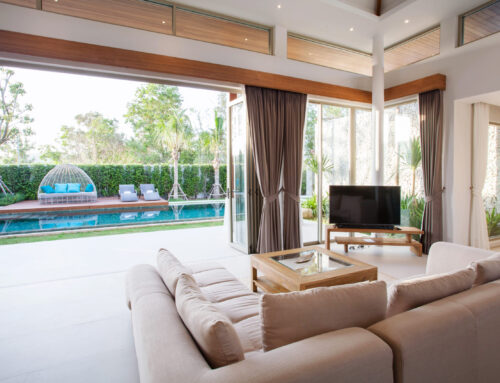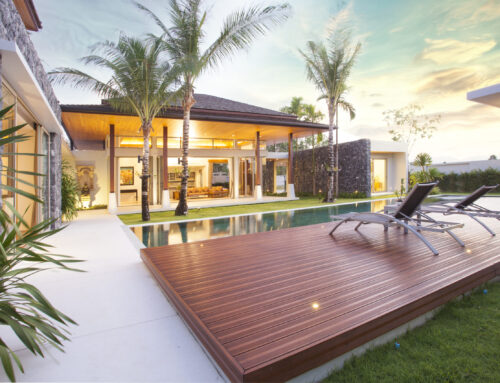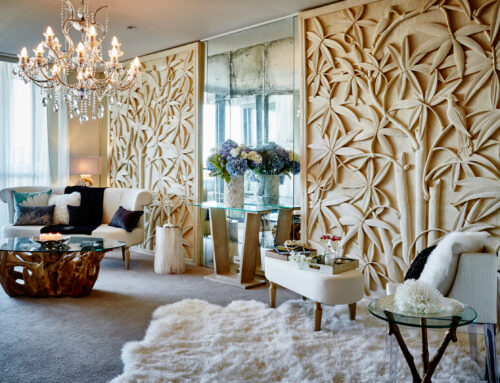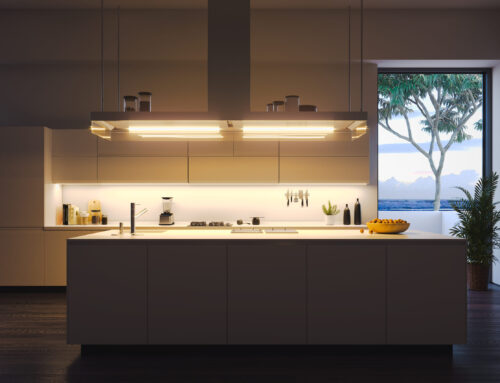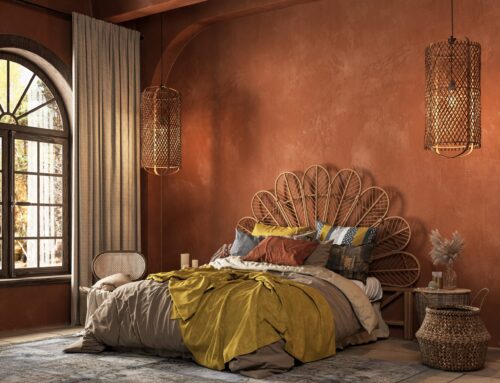A dramatic roof can take a house from lovely to extraordinary. Whether you are shopping for a new home or weighing remodeling decisions, the type of roof you choose will significantly impact the home’s structure and its exterior aesthetic. With this in mind, read on as we reveal some of the most dramatic roof styles currently capturing the imaginations of architects and designers.
Dramatic Skillion Roofs
A skillion roof (aka a lean-to) is worth considering if you want a home with dramatic angles. Unlike pitched roofs, a skillion roof is sloped in only one direction – sometimes significantly so. Better Homes & Gardens explains: “This style can be applied to specific areas of a roof or across an entire home to create a bold, contemporary home exterior.” If you want your home’s roofline to have a more dynamic feel, the Magazine suggests combining skillion roofs at “various angles across different sections of the roof.” In addition to creating an eye-catching exterior, a skillion roof also offers practical advantages to anyone living in regions with heavy snowfall or rain, as the steep angles grant quick precipitation runoff.
Sloping A-Frames
A-frame homes capture the eye and generate interest whenever they appear, but they enjoyed fervent admiration in the United States from the mid-1950s through the 1970s. It’s no surprise then that with the resurgence of interest in décor and design from that period, today’s architects are creating A-frame homes with even more dramatic roof elements. One of My Domaine’s favorite recent designs came from Milad Eshtiyaghi Studio. While one side of their Shawneetown home has a steep, traditional rise, the opposite side plummets down and then swoops out into a slope that inspires thoughts of ski jumps. It’s a twist on the original “that allows architecture to integrate with nature.” It works particularly well for this project, as magnificent trees and other woodland delights surround it.
Zig-Zagging Style
If you have ever seen a roofline that seems to be a series of peaks across the horizon, you are likely to have encountered a Zig Zag or M Shaped roof. Often seen on minimalist, modern homes and other structures, the jagged rising and falling pattern is undeniably eye-catching. And as the peaks often rise above upper-level windows, this dramatic roof allows homeowners to bask in additional streams of natural light.
Modern Flat Roofs
On the surface, the idea of a flat roof sitting at approximately 10 degrees of slope doesn’t seem revolutionary. However, its appearance never fails to impress. This roofline concept, found across the ancient world, was also much loved during the heyday of Mid-Century Modern design. And, of course, Mid-Century Modern is enjoying a resurgence right now. In fact, Martha Stewart Living is a fan of “this beloved flat-roof architectural style,” not only for its visually arresting roofline but for its “big glass windows, open, airy floor plans, and clean lines.”
Contemporary homes are also embracing this dramatic roof style. Contemporary houses, especially those in drier climates, often feature flat roofs because they are easy to maintain and offer the potential for additional outdoor living space (and incredible views). If you are inspired to add this roof to your new build or remodel, but you live in an area that sees significant rain or snow, work with your builder to utilize heavy-duty materials, like rubber roofing, to ensure that precipitation will drain quickly and that the roof can handle heavy snow accumulation.
Sloped Flat Design
As the name would suggest, a sloped (or sloping) flat design is a dazzling variation on the flat roof style. Depending on the degree of the slope, this dramatic roof design seemingly references a plane about to take flight, as the roof tilts skyward. Aside from its startling angle and impressive minimalism, this design is a darling for anyone who wants to enjoy protected outdoor space close to the house. Often, the roof extends beyond the home’s structure, creating an overhang supported by beams. This overhang can provide a shaded outdoor sanctuary, perfect for relaxing and entertaining. It also helps keep the inside of the home cool during the sweltering summer months.
Stunning Inversion Roofs
Picture a standard pitched roof with two vertical rises that meet in the middle at a point with a long horizontal span connecting them. Now flip that image upside down. While not always that extreme, inverted roofs (aka butterfly roofs) feature two “wings” that slope downward to create a valley over the house. Depending on your overall design, the valley could be dead center or offset. For larger luxury homes, it’s not uncommon for a butterfly design to cover one section of the house while others enjoy sloping flat or skillion styles.
Sleek Metal Roofing
Made from copper, zinc, aluminum, or steel, metal roofs boast longevity and fire resistance – a critical consideration in regions that experience fire seasons. Metal roofing is also recyclable and resistant to extreme weather conditions. Whether you opt for metal panels or shingles, the price can be quite high per square foot, even without customization. However, with a lifespan of 50 to 75 years, it’s not an investment you will need to make often.
As The Spruce points out, you don’t need a steeply sloping roof to make metal work. Standing-seam metal roofing can be installed on roofs that are gently pitched. The Magazine reports: “This type of roofing is installed in large sheets with seams that are raised and sealed tightly together to resist water. While some slope is necessary to ensure water runoff, most homes can accept metal roofing.”
Sleek metal roofing can brilliantly cap farmhouse, rustic, contemporary, and industrial homes and guest dwellings. Don’t be fooled into thinking that the metal must remain in its original color. In fact, vibrant shades that work as a contrast or in concert with your home’s color palette are encouraged. Better Homes & Gardens raves about a recent design favorite: “A metal roof dramatically enhances a three-story clapboard cottage. The bold red hue creates an appealing color palette when combined with the all-white exterior and surrounding greenery.”
Clay Tile Roofs
Houses completed with clay tile roofing undoubtedly benefit from the striking colors and eye-catching textures. While they can be extremely heavy and expensive, these beautiful tiles become exquisitely dramatic roofs for Mediterranean or Spanish-style estates. The Spruce raves that they are ideal for homes exposed to salt air, and they function exceptionally well in intensely hot climates, as their design helps keep indoor temperatures cool. It’s no wonder you often see this type of roof adorning stunning homes in California, the desert Southwest, and coastal Florida. The Magazine advises: “They can also be ideal for climates in which infrequent rains dump large amounts of water in a short time, since many styles are excellent at shedding rainfall from cloudbursts.”
Clay tile roofs are also an environmentally-friendly choice. The Spruce reports: “Tile roofs are made from earth minerals, not synthetic materials, and they can be pulverized and recycled when they are removed.” And given the range of rich colors and tile styles available, genuine roof customization can be yours.
Visit Distinctive Collection by Better Homes and Gardens® Real Estate when you begin your journey to buy or sell your unique home.



